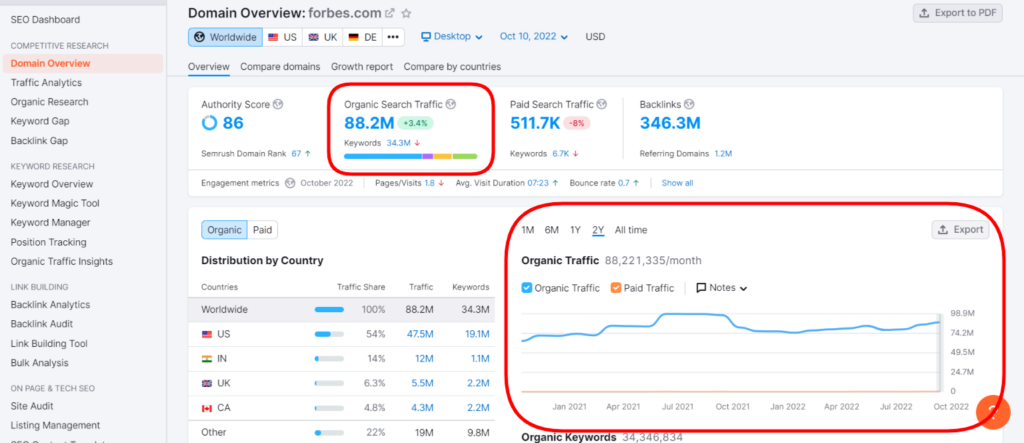Carmella
How to Measure
SEO Performance

SEO, or search engine optimization, unites several strategies to improve the website’s position in search results. What can you do to improve SEO? The algorithm used by Google includes more than 200 ranking variables. Due to this, activities range from relatively straightforward ones to technically demanding tasks, including:
- optimizing pages to attract targeted visitors;
- increasing the website visibility and crawlability by search spiders;
- customizing eCommerce site search;
- enhancing content to match the users’ requests.
For example, you may boost the website positions by inserting keywords in your copies or rewriting titles and meta descriptions. The content will become more SEO-friendly, with higher chances of attracting the needed audience.
As time passes, you may begin to question if you are doing things correctly. That’s where the issue of tracking SEO performance takes the stage. In this article, we’ll zero in on this task and enumerate some useful SEO measurement tools.
What Is the Aim of SEO, and Why Should You Measure Its Performance?
The end goal of SEO is to ensure stable traffic of unpaid visitors. It means search engines don’t charge the website for every click it gets. What matters when making the link appealing to click? It’s position.
The website should show up on page one of search engine results (SERPs). The most desirable place is as close to the top as possible since the first Google search result gets more than 25% of clicks. Higher positions on SERPs create a better business image and present it as an authoritative leader in its sphere.
However, many website owners understand that SEO is a time-consuming process. It takes time to show SEO results compared to paid advertising. You start from zero and build up the website’s authority every day. And consistency is the most critical aspect of SEO.
Compared to SEO, PPC (pay-per-click) works from the first moment of paying. The website appears in a special section for ads, having greater prominence than other results. However, the benefit of investing in SEO is that people perceive organic results as more reliable and authoritative than PPC ads. So it’s better to balance the two promotional methods.
As the outcomes from SEO aren’t immediate, you may spend weeks on insufficient strategies. For this reason, tracking SEO performance becomes crucial for preventing wrong investments and lost sales.
What Metrics Reflect SEO Performance?
You may have heard the common knowledge that you can improve only what you measure. And that’s where the first roadblocks emerge. There is a lot to track in SEO. And some unsatisfactory SEO results (as they may seem to you) don’t indicate issues with the website. Let’s look at the main website metrics connected to the effectiveness of SEO strategies.
1. Keyword Positioning
A keyword is a word or phrase people type in a search. These words should appear within the content for search crawlers to determine their relevancy to an input. Keyword positioning shows the place of the page with these keywords. Let’s take the Serpstat analytics as an example. This tool lets you check this metric for free after signing up for the service. This graph illustrates the distribution of keywords and their position in search. Screenshot taken on the official Serpstat website
2. Organic Traffic
Organic traffic is the ultimate goal of SEO efforts. These are visitors coming from organic search results, not from the paid ad section, so you don’t pay for every visitor. Organic traffic is a vivid indicator of your SEO performance because the more people you have, the better your SEO works. These are also targeted visitors. They come to the website to get a solution to a specific problem. If the website looks appealing enough and appears high on the SERPs, it will have decent traffic and encourage more people to perform the desired action. Consider Semrush to measure your organic traffic with Domain Overview and Traffic Analytics tools. The software presents a detailed comparison of the traffic sources for your and your competitors’ websites. You can spot trends and see them on the timeline. Screenshot taken on the official Semrush website
3. Click-Through Rate
The click-through rate (CTR) is the percentage of people clicking on the link from the SERPs compared to the total number of views. For example, 100 people saw the link, and just 10 of them accessed the website. The CTR will be 10%. This metric helps track SEO and how well meta titles and descriptions grab users’ attention. What if you notice low CTR? Take the following steps listed below:- Optimize your meta descriptions and titles by inserting relevant keywords, sticking to an optimal length, using numbers and appealing formatting;
- Add descriptive URLs;
- Create featured snippets;
- Focus on long-tail keywords;
- Use structured data and schema.org to help users navigate the website;
- Run split tests and adjust the elements according to the results.

4. Bounce Rate
Another signal when measuring SEO success is the bounce rate. It’s a metric in Google Analytics showing the percentage of people leaving the page.
The main point here is that visitors don’t take any action. No conversions. No clicks to other pages. They may still copy the contact information and buy on different channels, so the bounce rate doesn’t imply issues with the website. But in most cases, a high bounce rate often indicates that you need to optimize the website.
One of the common reasons may be irrelevant content or not meeting the user’s request in the first place. Other reasons include sluggish page loading, unreadable texts, or anything irritating and evoking the only desire to close the page immediately.

5. Conversion Rate
Conversion rate is another metric from Google Analytics. What can it tell you? It shows the percentage of people taking the desired action compared to the total number of visitors. The desired action differs from one industry to another. A conversion in eCommerce is usually adding products to the cart and proceeding to checkout. You may also want people to subscribe to a newsletter and YouTube channel or buy a book. How is a low conversion rate connected to SEO performance? The page should result in something. So if it produces few conversions, it’s time to revise readability, relevance, and other aspects to engage people, direct them to the necessary pages, and convert browsers into buyers.Conclusion
Here is how crucial SEO metrics and SEO measurement tools look. Now you can start measuring SEO success and improving the website’s ranking. How do you usually check whether the website moves in the right direction? Drop your comments below and share your tried-and-true strategies.

About the Author
Kate Parish is a chief marketing officer at Onilab. She has almost a decade of experience in the company and is still enthusiastic about every aspect of digital marketing. Kate sees the marketing mission in ensuring sustainable business growth. For this purpose, she helps companies and readers create efficient campaigns, solve common problems, and enhance crucial website metrics, such as conversions, bounce rates, and others.

Marketing tips without
all the "fluff".


Partnering with brands we believe in from the mountain peaks to the city streets.


Want to work with us?
USE THIS EMAIL
Want to say hi?
GENERAL INQUIRIES


